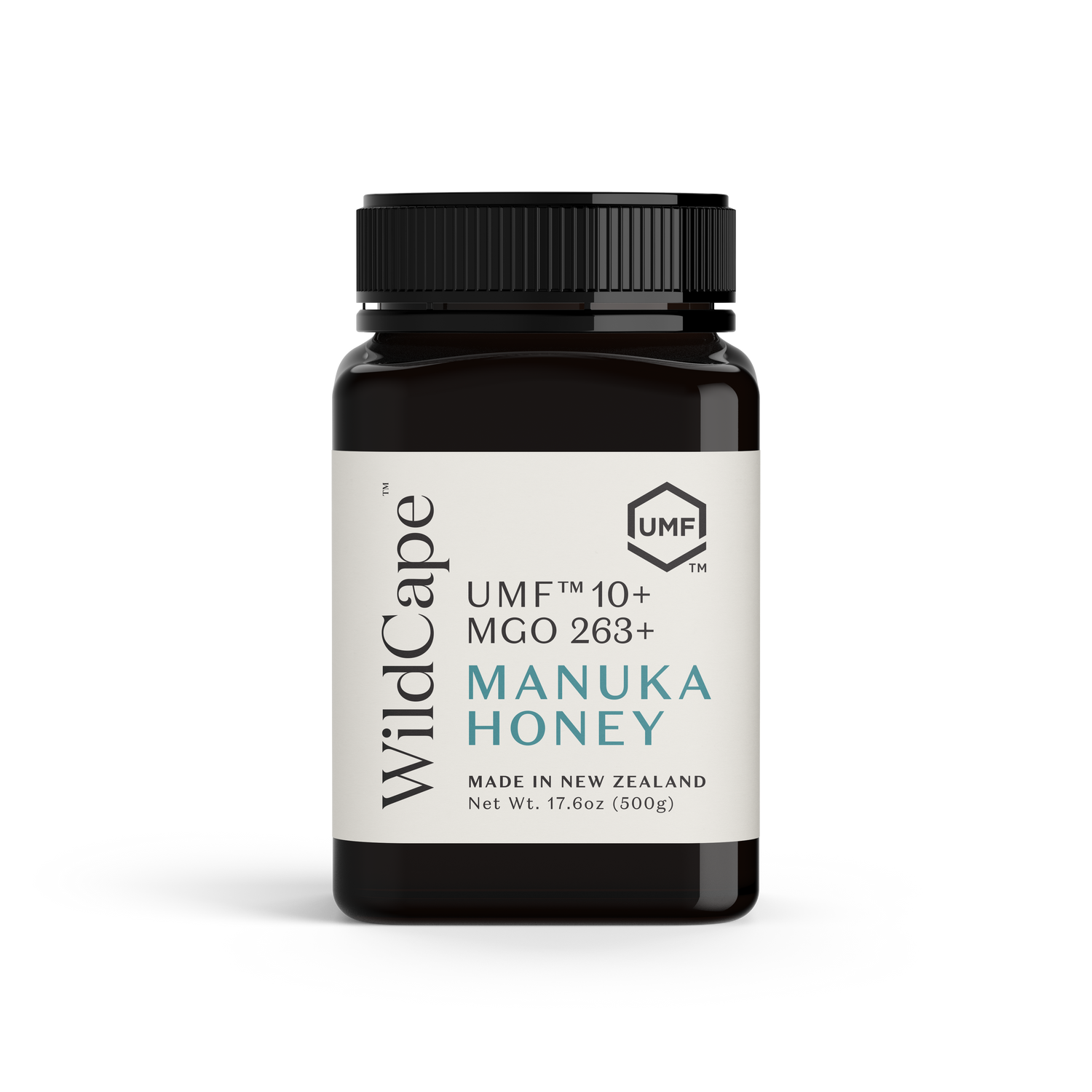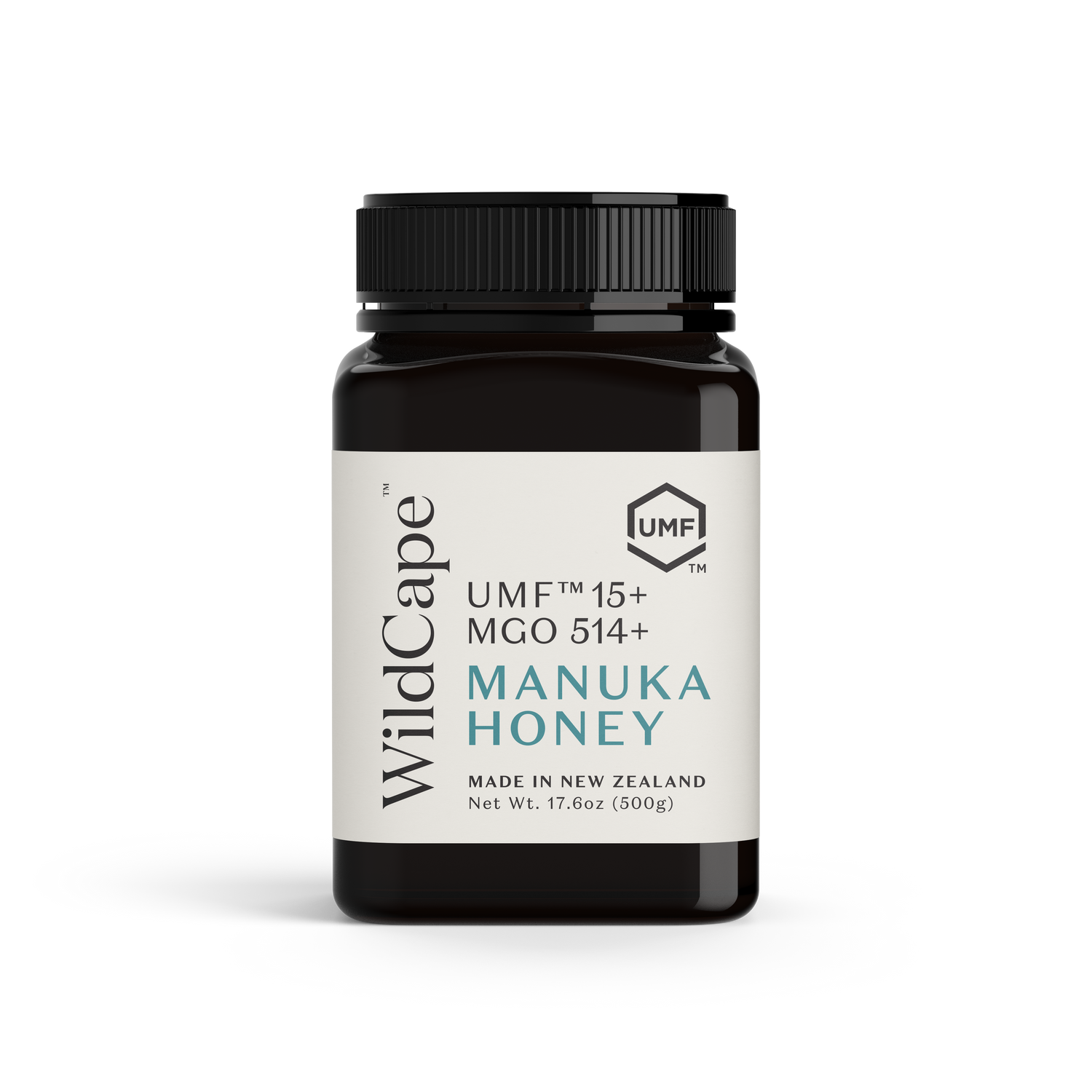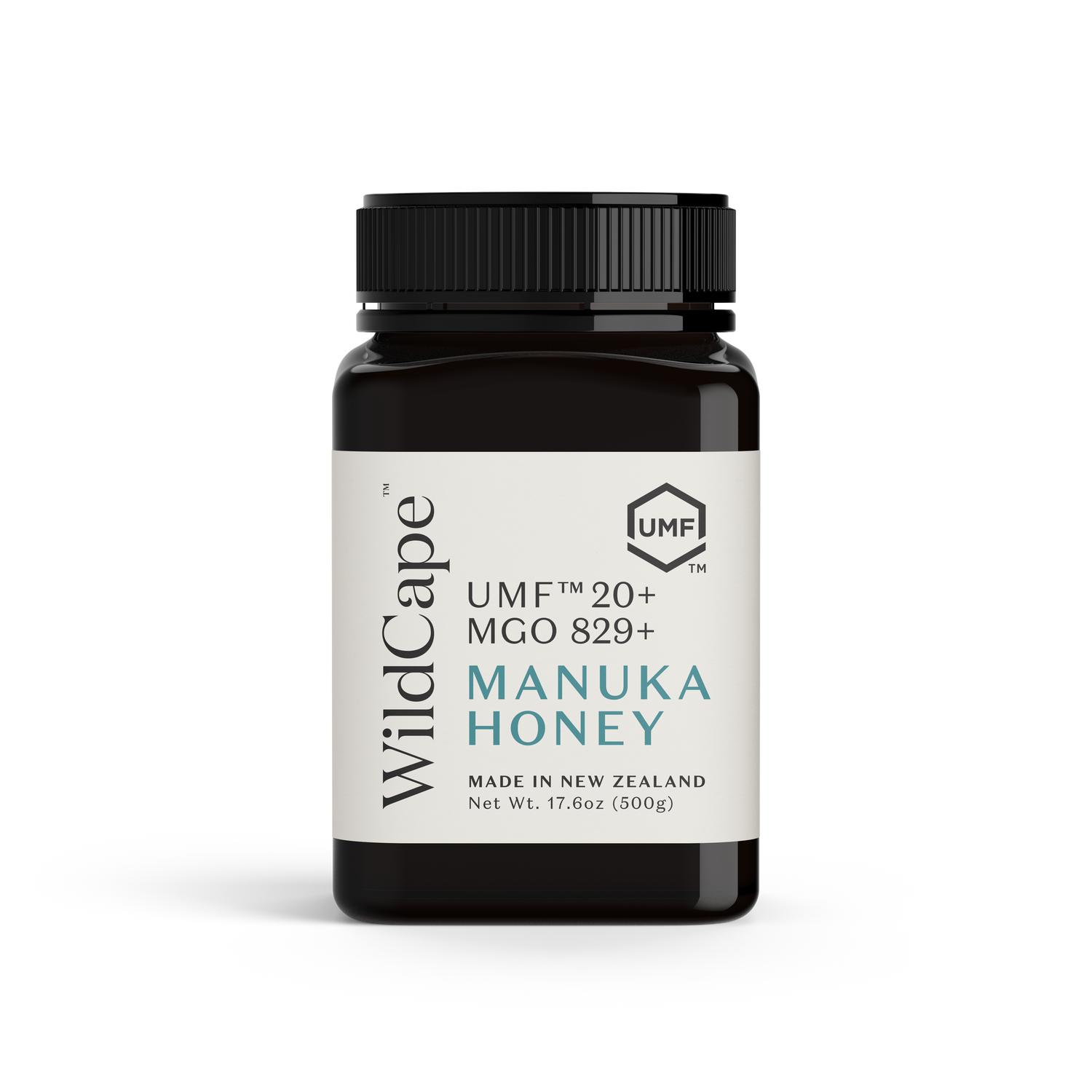Methylglyoxal (MGO) is only one of many important compounds found in genuine UMF-rated Manuka honey. It is, however, the key component, as it determines the potency of the special honey, and heavily influences the Unique Manuka Factor (UMF) rating. Although MGO in Manuka honey is critical in determining the UMF, there are three other key factors that determine the overall quality of Manuka honey. The UMF™ testing process, as set out by the UMFHA (Unique Manuka Factor Honey Association of New Zealand) measures all four unique signature compounds: leptosperin, dihydroxyacetone (DHA), methylglyoxal (MGO) and hydroxymethylfurfural (HMF). All four are present in high quality, genuine Manuka honey.
UMF Manuka Honey Rating System
The standard for the UMF grading System is set by the UMFHA:
“The beauty of mānuka honey comes from a complex collection of natural compounds that we call the Unique Mānuka Factors (UMF™) – and you won’t find it anywhere but in authentic New Zealand mānuka honey.
UMF™ is the only quality and rating system that independently certifies the presence and quality of all factors that make New Zealand mānuka honey unique, ensuring you get honey that meets your needs. Check for the UMF™ quality mark on the front of pack when choosing your mānuka honey.”
Manuka Honey UMF vs MGO
MGO vs UMF – what’s the direct correlation between UMF and MGO? The potency of Manuka honey is dependent on its MGO content. So, generally speaking, the higher the MGO, the higher the UMF rating. Although there are other important factors that contribute to the UMF rating.
Did You Know?
Honey that comes from the East Cape of New Zealand is naturally high in MGO. East Cape honey is also noticeably better tasting. Where some Manuka honey can have a strong medicinal taste, East Cape Manuka honey has a milder taste profile, making it a popular choice among Manuka honey enthusiasts the world over.
A Breakdown of the Four Compounds That Determine UMF Rating
So why are all 4 compounds considered in the UMF™ grading system? Why not simply measure the potency which is determined by the amount of MGO? It’s important to measure all 4, since they work together to achieve a high-grade Manuka honey. It’s about much more than just potency. Let’s see what role each of these compounds play.
1) MGO (Determines the potency of Manuka honey.)
Methylglyoxal, also known as MGO, is the active ingredient in Manuka honey that gives it its unique antibacterial properties. The concentration of MGO is often used as a measure of potency. When purchasing Manuka honey, look for the UMF™ mark to ensure that the product has been certified to contain the special activity associated with MGO. MGO is said to have antibacterial properties.
2) Leptosperin (Measures authenticity.)
Leptosperin is a naturally occurring compound that is found exclusively in the nectar of Manuka flowers. Testing for the presence of leptosperin is a reliable way to verify the authenticity of Manuka honey. In addition, laboratory studies have shown that higher levels of leptosperin are associated with anti-inflammatory properties. When purchasing Manuka honey, look for the UMF™ label to ensure that the product has been certified to contain leptosperin.
3) DHA (Determines shelf life of living Manuka honey.)
Dihydroxyacetone (DHA) is a compound that is converted to MGO in living Manuka honey. The stability of MGO in the honey is directly related to the amount of DHA present. To be UMF™ certified, Manuka honey must contain more than 70 mg/kg of DHA. This ensures that the honey will have a long shelf life and maintain its powerful antibacterial properties.
4) HMF (Measures Freshness.)
The UMFHA tests for hydroxymethylfurfural (HMF) to ensure that the Manuka honey has not been overheated or stored for an extended period of time. HMF levels can indicate the quality and freshness of the honey. By checking for HMF, the UMFHA can ensure that the Manuka honey you receive from your favorite supplier has the full range of living properties it promises.
When we read that “New Zealand produces 1,700 tonnes of Manuka honey, but 10,000 tonnes are sold globally” (NZ Herald) it becomes clear that many consumers have been paying very high prices for a product which is anything but New Zealand Manuka honey.
Manuka Honey MGO Chart
Using this MGO calculator, you can see the MGO to UMF ratio, amongst other important compounds that award a given Manuka honey its appropriate UMF factor.

Manuka Honey vs Regular Honey
Regular New Zealand Honey, although super tasty and also beneficial to your health, does not compare to the healing qualities of Manuka honey. Manuka honey’s healing properties are much higher than standard honey due to the presence of MGO. The MGO is Manuka honey is derived from the Manuka bush and is not present in any other honey in the world.
If you have to choose between regular or Manuka, Manuka honey is best.
Monofloral vs Multifloral Manuka Honey

Monofloral Manuka honey is made from the nectar of the Manuka bush only, while multifloral Manuka honey is made from the nectar of other plants as well. Monofloral honey is considered to be more potent and has higher antibacterial activity compared to multifloral Manuka honey. This is because it contains a higher concentration of the antibacterial compound methylglyoxal (MGO), which is found in higher amounts in the nectar of the Manuka bush compared to other plants.
It is important to also note that Manuka honey’s potency varies depending on where it is sourced and how it is processed, and it is important to find a reputable source, which can guarantee the authenticity of the product.
WildCape is the only UMF Certified single source Manuka honey that’s harvested exclusively from the East Cape region. As mentioned, the East Cape is well known to produce some of the finest Manuka honey in the world.
New to Manuka Honey?
WildCape USA offers UMF 10+, UMF 15+ and UMF 20+. Click on each product to learn more! If you’re still unsure, you can also follow the UMFHA’s guidelines on which UMF rating is right for you.
Where Can I Buy Manuka Honey?
You can find Manuka honey in stores or online. The easiest would be Manuka honey sold online. You can buy Manuka honey directly from our online storeby clicking on one of the products below.



